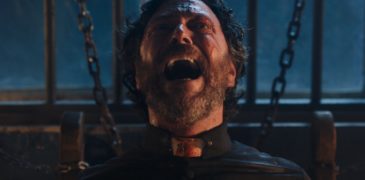Chris Nash’s In A Violent Nature (2024) will get under your skin and claw at your brain from the inside, leaving you begging to look away, but you won’t. You’ll stick with every moment of this film, literally glued to the maniac’s side, right up until the last drop of blood has been spilled. You’ll find your heart thumping wildly and your jaw dropping when Johnny (Ry Barrett) brutally slays his victims, and you won’t be given a place to hide. Johnny is on a mission of painful retribution, and you’re his reluctant (or eager, you weirdos!) cameraman.

The film opens with several unseen male voices standing off-camera in a forest, joking about the camping trip they’re about to enjoy with a few female friends. The camera is focused on a dark patch of ground, where a gold locket hangs from an old pipe jutting from the dirt. One of the young men takes it and walks away, unaware that he’s just released the bound spirit of Johnny, a mentally challenged young man who was relentlessly bullied and eventually accidentally died on the site years before. The viewer has no idea what they’re in for at this point. It could go either way: cheesy slasher, or seriously scary. Johnny rises from his grave and begins his path of destruction with a very slow plod through the forest. His pace is so slow, and it takes so long for anything to happen, that the viewer becomes uncomfortable watching him from their position several feet behind him. There is no musical soundtrack, just the sound of leaves and sticks crunching beneath his feet, and the noise of insects and birds in the distance. It’s disconcerting. When we do hear the next voice, again it’s from a distance and off-screen. Johnny has arrived at his first destination: his childhood home. He’ll make his way to the camping grounds where he died, but he’s looking for something, first.
Nash’s direction in this scene is outstanding and sets the tone for the rest of the film. Johnny and the victim are always just a few paces away from one another but seem oblivious to each other. Where this could have become comical or cringey under someone else’s direction, Nash kills it. The sound of the victim’s voice carrying on around the house and yard while Johnny plods through his space unseen is crystal clear but distant. The sound editing throughout the film is phenomenal, but this is the first place we experience the uncanny feeling that we are Johnny, that we’re perceiving the world through his eyes and ears.

We follow Johnny’s trek from an unsafe distance, watching almost everything with his back center screen, so we’re forced to watch the story unfold at his slow pace. This is intentional, keeping us uncomfortable with no option but to follow him. We meet the campers when he gets close to their cabin, and only hear/see what Johnny hears and sees. It’s a clever device, and it’s executed with perfection. We were unlikely to develop any sympathy for the victims because that’s not Nash’s goal with this film. He wanted to hogtie us to the villain and make us balk at Johnny’s actions, which we do in full colour. Johnny’s kills are not just creative, they are among the goriest scenes in any slasher movie, ever. Nash does things most people would not dream of in their wildest imaginations. The fact that the gore is practical (as opposed to special effects) just makes them that much more impressive.
Seemingly unimportant details in the story feel like they were scrutinized from every angle before and during filming. In the second kill, for example, the victim’s cassette-playing Walkman remains attached to the body’s hip, its thready music barely audible through headphones as Johnny drags him to the ranger station. The amount of time it takes him to get there is expressed through the slowing music, a sound any Gen-X viewer is familiar with: the batteries are dying and the tape’s play speed is winding down, distorting the singer’s voice. It’s one example of Nash’s “show don’t tell” ability that sets his storytelling apart. Johnny’s back story is revealed through a campfire ghost story, which again could have created a bubble of silliness in the middle of the film, but because we see it being told from Johnny’s position just beyond the treeline, it’s anything but silly.

Between the slow, methodical pace and the uncannily clear sound that is uninterrupted by music, In A Violent Nature is an immersive slasher that feels more cerebral than arthouse. It’s experimental, but there is nothing philosophical to this story. It’s about pure, maniacal retribution, driven by a derivative of Jason Vorhees that is somehow elevated, and more mature. Johnny’s motivation is clear, and none of the victims really matter. They could have been anyone. We only know what Johnny knows for the majority of the runtime; the victims are given minimal full-screen time, just enough to move the plot forward.
While the entire cast gave commendable performances, Ry Barrett’s portrayal of Johnny is outstanding. From his steadily paced marches through the forest to his forlorn touch of the glass case protecting an old firefighting mask at the ranger outpost, Barrett gives us more insight into his character’s motivation than any lines could have. His reaction to finding the last survivor’s keys with a dinky car dangling from a small chain near the end of the film shows us just how developmentally delayed he really was in life. His outbursts of rage, in hindsight, show us just how tormented he must have been because of his disability.

Writer/director Chris Nash’s first feature-length film, In A Violent Nature, sets the bar high for future slashers who want to be taken seriously. It’s more than Jason Vorhees, and it’s more than arthouse. In A Violent Nature is an utterly disturbing glimpse into the methodical patience and psychopathy of a supernatural being exacting his revenge, from his perspective. He shows no emotion, he never speaks, and he never breaks his stride. We dare you to watch it with the lights off, just like you did as a kid at sleepovers watching the Friday the 13th series, and experience the difference in Nash’s film. We guarantee you won’t be going camping anytime soon, and you’ll leave treasures found in the forest where they lie.
In A Violent Nature is now streaming on Shudder.

More Film Reviews
It is safe to say that the global coronavirus pandemic has drastically changed our world and the way we both operate and interact within it. Nowhere has this been more… Being one of the most attributed inspirations in filmmaking, filmmakers around the world have cited The Evil Dead series as a motivation to create cinema for themselves. The mastery of… Cosmic Dawn is one of those films that is difficult to summarize, wherein the plot is not nearly as important as the experience. Furthermore, the production fluctuates between amateurism and… One of the biggest highlights of the Japan Film Fest Hamburg rests within the diverse selection of short films. For the audience, this means getting the chance to see original… The exorcism subgenre can be a bit of a double-edged sword. It’s so easy to rely on cheap makeup effects and jump scares to quickly turn a profit, which is… In 2017, the United States Air Force carried out an airstrike in the Nangarhar Province, Afghanistan. Deploying the largest non-nuclear bomb in their arsenal (the MOAB), they aimed to destroy…The Day of Destruction (2020) Film Review – A Punk Rock Shout to the Soul for the Pandemic Age
Bloody Muscle Bodybuilder in Hell (2012) Film Review – A Rush Of Blood To The Dead
Cosmic Dawn (2022) Film Review – Drink the Canadian Kool-Aid!
Japan Film Fest Hamburg JFFH 2021 – Short Films Spotlight
The Exorcism of God (2021) Film Review – Tough Questions Require an Exorcist
The Lair (2022) Film Review | Toronto After Dark Film Festival

Kate’s love of all things dark began as a child and deepened when she realized what being an adult meant. She was born with a pencil in her hand and loves nothing more than writing horrific stories to tantalize her inner demons. Kate lives in Hamilton, Ontario Canada with her husband and her boys, stirring up trouble wherever she can.






